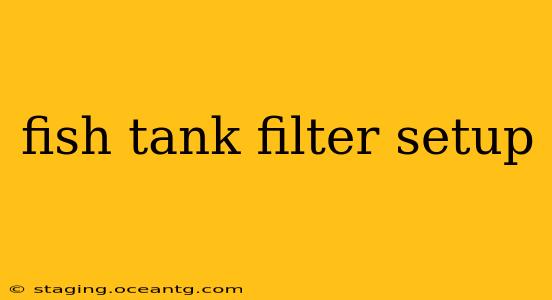Setting up a fish tank filter is crucial for maintaining a healthy aquatic environment. A properly functioning filter keeps your fish thriving by removing waste, controlling ammonia levels, and ensuring clear, clean water. This comprehensive guide will walk you through the process, answering common questions and helping you choose the right filter for your tank.
What are the different types of fish tank filters?
There are several types of fish tank filters available, each with its own advantages and disadvantages. The best choice depends on the size of your tank and the type of fish you keep.
-
Hang-on-back (HOB) filters: These are the most common type, easily attached to the back of the tank. They're relatively inexpensive, easy to maintain, and suitable for most tank sizes.
-
Undergravel filters (UGF): These filters use a plate of porous material under the gravel to draw water up through the substrate. While effective at biological filtration, they can be less efficient at mechanical filtration and require more maintenance.
-
Canister filters: These external filters are powerful and efficient, offering excellent mechanical, chemical, and biological filtration. They are ideal for larger tanks but require more initial investment and setup.
-
Internal filters: These submersible filters sit inside the tank and are a good option for smaller tanks or as supplementary filtration.
-
Sponge filters: These are simple, low-maintenance filters suitable for smaller tanks and breeding setups. They primarily provide biological filtration.
How do I choose the right filter for my tank size?
Choosing the right filter size is critical. A filter that's too small won't effectively clean the water, while one that's too large might create excessive water flow, stressing your fish. Most manufacturers provide flow rate information based on gallons per hour (GPH). Aim for a filter with a GPH that's approximately 4-6 times the tank's volume. For example, a 20-gallon tank would benefit from a filter with a 80-120 GPH flow rate. Always check the manufacturer's recommendations for your specific tank size and type of fish.
What are the different stages of filtration?
Effective filtration involves three primary stages:
-
Mechanical filtration: This stage removes large debris like uneaten food, fish waste, and dead plants using physical barriers like filter pads or sponges.
-
Chemical filtration: This stage uses activated carbon or other media to remove dissolved impurities, toxins, and discoloration from the water.
-
Biological filtration: This is the most crucial stage. Beneficial bacteria colonize filter media, breaking down harmful ammonia and nitrite into less toxic nitrate, which can then be removed through water changes.
How often should I clean my fish tank filter?
The frequency of filter cleaning depends on several factors, including tank size, the number of fish, and the type of filter. Generally, you should rinse the filter media (sponges, pads, etc.) in old tank water every 2-4 weeks. Avoid using tap water, as it contains chlorine and chloramine which can harm the beneficial bacteria. Completely replacing the filter media should only be done every few months to avoid disrupting the beneficial bacteria colony.
How do I clean my fish tank filter media?
Cleaning your filter media properly is essential. Never use soap or detergents, as these will kill the beneficial bacteria. Simply rinse the media gently in old aquarium water until the debris is removed. Squeeze gently to remove excess water and return the rinsed media to the filter.
What are the signs of a failing fish tank filter?
A failing filter can lead to a variety of problems, including:
- Cloudy water: This indicates an imbalance in the filtration system.
- High ammonia or nitrite levels: These are toxic to fish and indicate inadequate biological filtration.
- Strong odors: A foul smell emanating from the tank usually signifies a problem with waste removal.
- Fish behaving strangely: Stressed fish may exhibit unusual behaviors like gasping at the surface, lethargy, or loss of appetite.
If you notice any of these signs, inspect your filter and address any issues immediately.
This detailed guide should provide you with a solid understanding of setting up and maintaining your fish tank filter. Remember to always research the specific needs of your fish and choose a filter that meets those needs. Regular maintenance and attention to detail will ensure a healthy and thriving aquatic environment for your finned friends.
